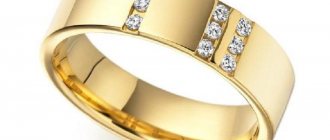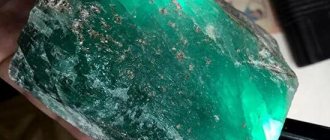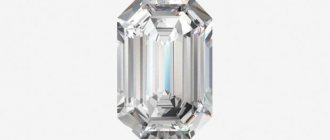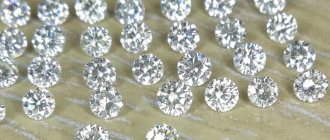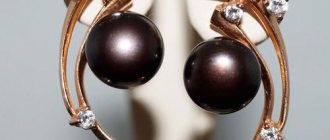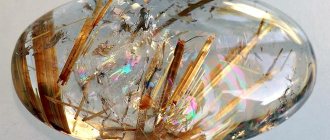Hello, dear readers! Emeralds have attracted the interest of mankind since ancient times; even the rulers of Egypt loved not only jewelry made from them, but also preferred to wear clothes inlaid with them. This type of beryl is not found in nature as often as diamonds, so their prices are often higher. Unfortunately, unscrupulous craftsmen take advantage of this and try to pass off other cheaper stones as gemstones, so the table of emerald purity can help you understand where the real nugget is and where it is an imitation.
Purity of emerald
The more transparent the emerald, the higher its quality. Based on purity, the stone is divided into several types. They are designed to make it easier to set the price of a mineral. There are 3 groups of this jewelry material that have a serious impact on the price:
- high-quality samples (the purest stones);
- emeralds are of medium quality (may be cloudy, with small defects);
- low quality minerals (the worst workable minerals).
It is important to understand that this method of determination has a great advantage - it does not require auxiliary elements or instruments. Thus, anyone can evaluate the quality of a gemstone. However, it is necessary to pay attention to the fact that there are official criteria by which jewelry makers set the cost.
Treatment.
There are many ways to treat emerald to improve its quality. For example, internal cracks in stone that reach the surface are filled with resins to hide them.
Such methods are common practice. However, you need to keep this in mind before subjecting your emerald jewelry to ultrasonic cleaning. Ultrasound can destroy fillers, so in this case it is best to use gentle cleaning methods. For example, use a damp cloth to remove accumulated dirt.
Sometimes emeralds are dyed to deepen their color. But such stones are considered less valuable and therefore they are cheaper.
Stone purity table
The classification of emeralds is quite simple to master, but there are also controversial stones. Such minerals have mixed features belonging to different groups. Most emeralds, if you know certain grading rules, are easy to identify. For this reason, the purity of a gemstone can be determined simply by looking at the main features. Distinctive features of the distribution are listed in a special table:
| Group | External characteristics |
| High quality (G1) | The sample should not be cloudy. The presence of serious defects is also considered unacceptable. The material may have small scratches, but they should not be deep or long. Many small defects are also unacceptable: the number of cracks should be minimal and not harm transparency. |
| Average quality (G2) | Such emeralds may have slight haze. Variations in cleanliness are also acceptable. Subtle stripes may be numerous. The number of deep scratches should be insignificant (preferably completely absent). Inclusions are allowed if they do not greatly affect the purity of the mineral. Defects can create a so-called “network”, which is expressed in sharp pinpoint opacities. |
| Low quality (G3) | Such a stone may have noticeable cracks. The purity of the sample is minimal - the mineral is practically opaque. The amount of damage can be any (most often located on all sides of the material). Low-quality emeralds usually have large variations in clarity. Particularly turbid areas often lack the characteristic shine. |
You need to know that any mineral has some flaws. This is due to the peculiarities of stone mining. Please note that the quality of the emerald is affected by the cutting method. Separately, it is customary to highlight the cabochon, which has a particularly strong effect on the material used. The quality of such emerald is lower, and the division is present only into 2 groups:
- Average quality (K1). The external features of such a mineral are similar to representatives of the G2 group. The stone may also have various defects and slight clouding. However, the distinctive feature is that such an emerald, despite its flaws, can be completely transparent. Also, this group is not characterized by the presence of networks.
- Low quality (K2). The stone of this processing method is very different from other low-quality counterparts. The number and brightness of the manifestation of defects in such a stone are maximum (most often noticeably exceeding the G3 indicators). A faint shine is usually present: it is evenly distributed throughout the emerald. Another distinctive detail is that the stone is transparent or translucent.
A cabochon worsens the condition of the material, increasing the number of flaws. On the other hand, it often has a positive effect on the clarity of the gemstone. It should be noted that occasionally there are emeralds that have no defects at all, even with this cut. However, it should be understood that in most cases such minerals are fake. To determine whether such a unique stone is natural, it is recommended to contact a specialist.
Framing.
The setting of the emerald should protect it and preserve it so that it does not fall out. For better protection, it is best to use V-shaped teeth. This setting is best suited for angular shapes.
It is better if V-shaped teeth are placed at the very corners of the stone to protect its edges from possible impacts and damage. Also the safest is a blind setting.
It frames the stone around the entire perimeter with a metal strip, which protects it from external influences.
The blind frame can be full or partial. That is, completely edging the stone or some of its sections.
Where is it mined and how is it processed?
The deposit influences the color and quality. This means that the location of extraction directly indicates the cost of the jewelry. Emerald, as one of the most popular gemstones, is considered quite common. It is mined in many countries, among which the highest quality stands out:
- Colombia (the largest amount of this material is mined here, which is cast in transparency and color saturation);
- Russia (the deposits are distinguished by the large size of the mined emeralds);
- India (stones of medium saturation and size, quite clean and numerous);
- Africa (the deposits are similar to Colombian ones, but the minerals are of even higher quality and small in size);
- Brazil (emeralds are translucent, but extremely clear, with a yellowish tint).
There are other deposits of this gemstone, but the number of samples mined there is small. It should be noted that the quality of such emeralds is also quite low. Zones characterized by high quality of extracted material are more likely than others to use the open-pit mining method. This method involves simply digging up a stone located close to the surface. The advantage of the method is that the likelihood of damage to the found emerald is low. However, finding a suitable sample for processing is extremely difficult. The mining method, which is the most common mining method, allows the material to be collected much faster.
Emerald color classifications
In addition to the purity of the emerald, color groups are distinguished. This mineral has different shades, some of which are quite rare. Please note that emerald always has a green base. This gemstone is usually divided into the following varieties:
- Yellow. It is implied by the presence of a warm shade against a green background. The yellow color is usually not bright. The green base is most often distinguished by its richness and depth. This group is considered one of the most common. It is rare to find specimens with a strong manifestation of yellow or even red hues.
- Blue. These emeralds are often distinguished by their dark color scheme. The foundation can be either rich or dull. The most common shade is blue, but this group also includes purple and turquoise shades. Minerals in this group are often of low quality.
- Pure green. Considered the best option. They should not contain any impurities, even in the smallest manifestations. Stones that are as bright as possible are preferred. Such representatives are distinguished by the greatest transparency.
Sometimes in these stones you can notice impurities of other colors. There are examples with a reddish tint, but they are easily confused with red or bright yellow shades. It is extremely rare to find emeralds mixed with bright purple or pink. It is important to understand that the brighter any shade, the less pure the stone. Such minerals often have increased fragility and excessive turbidity. Yellow pale emeralds with low transparency are usually classified as beryl.
Additional assessment factors.
Additional factors for evaluating emeralds include:
— Optical phenomena. Optical phenomena in emeralds include the “cat’s eye” iridescence effect and the “butterfly wing” light scattering effect. In the case of a “cat’s eye”, the degree of severity and perfection of the existing effect is assessed. And for the “butterfly wing” effect, the fact of its presence is important.
Emerald cabochons with cat's eye iridescence effect
— Patterned textures. Patterned emeralds include a texture that causes the presence of a “pattern” of the “trapiche” type, which is caused by the twin growth of crystals within one mineral deposit. If a trapiche pattern is present, its decorative properties are assessed.
— Availability of reliable information about the stone mining region. Relevant for stones from Colombia, Afghanistan, Zambia. For Russia, the fact of stone mining in the Emerald Mines region (Middle Urals) may also be important.
— Availability of a gemological report from a reputable gemological laboratory (Gübelin, GRS, GIA, SSEF, GIT).
Separately, the fact of improvement is considered as a reducing factor in the assessment. Types of refining of emeralds include:
— Filling cracks in emeralds with extractable fillers – oil and wax. Used to improve the visual perception of transparency or purity of a stone. For most stones this method of refining is acceptable, but for stones of high quality characteristics it is not desirable.
— Filling cracks and cavities with extraction-resistant fillers – artificial polymers. Just like the previous method, this type of refining improves the external perception of transparency and cleanliness, but is undesirable. Very rarely, glass is used to permanently fill cracks and cavities.
— Enhancing the visual perception of color by filling cracks with coloring compounds or surface painting. If this treatment is used, the stone can no longer be called an emerald.
Characteristics of emerald in jewelry
It should be noted that this gemstone is not always treated. The majority of samples require cutting, which negatively affects their quality. The best are considered rare representatives that do not require any processing. There are also 2 separate groups of emeralds, depending on the cut:
- light cutting (stones that have undergone minimal decorative processing);
- full cut (minerals of the lowest quality).
In this case, processing affects the degree of transparency and the presence of flaws. The gemstone should be as clear as possible (opaque materials are not used).
Helpful information
In terms of color, the most popular are representatives of the deep blue shade. In second place are samples of rich green color. The duller the mineral, the less valuable it is. Yellowness is considered a negative indicator, and therefore reduces the value of the emerald.
Does refining a gem affect the price?
True connoisseurs of emeralds know that refining reduces the cost of a stone by 40-60 percent, that is, an unrefined mineral of the same quality will cost many times more. But today it is almost impossible to find an impeccable nugget that does not need refining.
Most often in Russia, cracks in a gemstone are hidden using cedar oil; this refining process can be carried out more than once. Finding jewelry that is not oiled is actually not that easy.
How to determine quality
Despite the fact that the influence is exerted exclusively by external characteristics, it is difficult to independently determine the degree of value of some stones. The presence of stages for determining quality simplifies this process:
- Consideration of the authenticity of the material. Artificial emeralds have a noticeably lower cost, as well as quality.
- Study of mineral cutting. Processing negatively affects not only other external indicators, but also makes the stone more fragile.
- Determining the purity of an emerald. Please note that there are samples that are intermediate, i.e. their group cannot be precisely determined.
- Color. It is recommended to determine this parameter by comparison with other representatives. Moreover, it is necessary to examine the stones in good lighting, otherwise they can significantly change their shade.
It is important to understand that you cannot determine the quality level from photographs. Close inspection is required to find minor defects or clouding. In poor lighting, it is permissible to use a magnifying glass. It is not recommended to determine the shade under the sun's rays, as they cause the appearance of yellowness. The most suitable light will be cold light, which will have the least effect on the color of the mineral.
LOW QUALITY EMERALD
Weight
The mass of the stone is the next characteristic. The larger the natural emerald, the higher its cost per carat. Because rarity already influences this - large stones are found less often than small ones. Unlike rubies, sapphires or diamonds, large emeralds are more often found in nature; although they are rare, their quantity on the world market is greater than the above listed stones.
In the photo: a large 11-carat example from Colombia
“Practical advice. You can roughly estimate how a cut emerald will look when mounted in a product. To do this, you need to place the stone on top of your fingers. Shake your palm in different lighting and appreciate the overall appeal and quality. Do you like him or not? In the same way, by placing several samples on your fingers at the same time, you can compare them to choose the best one.”
On video: large Colombian emerald - 9.46 ct
— In the second part, we will look at factors such as the cut of the emerald, its deposits, the presence of refining and the certificate. We’ll also tell you about the varieties. — In the third part we will show you the real prices for emerald per carat.
READ MORE
Price
The price of an emerald can vary greatly. Stones with low clarity and a pronounced yellow or red tint are the cheapest. The most popular are the pure green representatives, most of which are mined in Colombia.
Helpful information
The cost of the most expensive stones can reach several million dollars. They are raw, pure emeralds of rich color with a vibrant blue tint.
Such minerals are very rare, which is explained by the small amount of mined material and the low transparency of most of the samples.
Treasures of the Mistress of the Copper Mountain
The famous Ural deposit, where emeralds have been mined since the mid-19th century, deserves a special mention. The Mariinsky mine (currently the Malyshevskoye deposit), which produces the most generous emerald ore for gems, has produced a large number of very large specimens during its existence. In total, over 15 tons of crystals were mined in the Urals. Ural emeralds are valued for their purity and rich May green color.
The largest gems receive their own names. More recently, in 2012, a crystal weighing 637 was found. It was named “Jubilee” in honor of the 65th anniversary of the mining plant. And the unprocessed emerald weighing 1200 g (6 thousand carats) found in 1993 was named “President” by the Urals in honor of fellow countryman B. N. Yeltsin.
It was arrested for the plant's debts, but was subsequently purchased by the Diamond Fund for $150,000, although the real value of the stone is much higher. The “Glorious Ural”, mined in 1978, weighing 3362.5 carats, is also located there.
A grassy-green crystal of rare purity, mined in 1834, became the record holder of the Ural mines. It was called the “Kokowina Emerald,” but soon this stone was irretrievably lost. Some sources suggested that the mineral was first stolen and then cut into pieces to avoid exposure. Now another precious stone bears the same name: an emerald from Kochubey’s personal collection, which is now in the Mineralogical Museum. A.E. Fersman RAS. Its weight is 2226 g (about 11 thousand carats).
Gold earrings SL with emeralds and diamonds (go to the SUNLIGHT catalogue)
